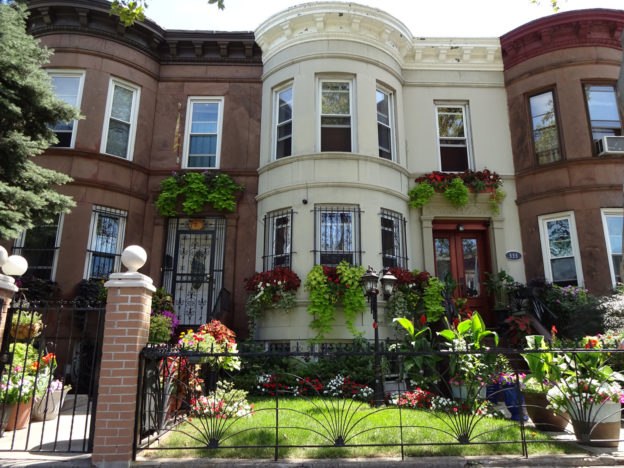1027 Flatbush Ave
1920
Harrison G. Wiseman
The Albermarle Theater opened in 1920, hosting vaudeville shows and motion pictures. Above the auditorium there was a grand banquet hall, with an entrance on the side.
Although it wasn’t initially considered a success, the theater became a neighborhood staple and remained in operation until a fire partially damaged the structure in 1984. After being closed for several years, the building was purchased by the Jehovah’s Witnesses and presently serves as their Kingdom Hall.
The main façade has a central bay with terra cotta cladding and flanking bays in red brick. Carved ornamentations, also in terra cotta, frame window openings and divide the second and third floors, as well as the pediment marking the entrance. The building is capped by a Doric cornice, and at each corner there’s a double-height pilaster. Most of the ground openings have been sealed, with the exception of the entrances on Flatbush Avenue and Albemarle Road.
2273 Church Ave
1936
Lorimer Rich
This two-story brick structure evokes the form of an idealized residence from the colonial period, making it a more academic example of Colonial Revival than most 1930s post offices in New York state, which had a more stylized manner. It features modest ornamentation, with the main entrance marked by a large limestone panel with the name of the post office inscribed in Colonial style script. The interior is laid out in a utilitarian manner, with a rectangular lobby and no ceremonial spaces. It maintains the original terrazzo floors and a few of the marble panels on the lower part of the walls.
It was one of seven postal stations commissioned to Lorimer Rich as part of the “New Deal” program, created by the federal government to promote economic recovery after the Great Depression. Rich was best known for the Tomb of the Unknown Soldier in Arlington National Cemetery. It was listed on the National Register in 1988.
2286 Church Ave
ca. 1750s-1850s
Until the 19th century, Flatbush was mostly a rural area devoted to agriculture, with Dutch settlers relying on enslaved Black laborers to work their land. Family cemeteries on these farms are known to have had separate burial sites for these workers, but their location was often excluded from records and obscured.
Information about the existence of a burial ground in the area was provided in 1810 by the publication of an obituary for a Black woman named Eve, as well as on a map from 1855. Local historians also mention the relocation of remains when Bedford Avenue was laid out in 1865.
In 1878, this site became the location for the Flatbush District School No.1, later P.S. 90. Reports noted the discovery of human remains during construction work in 1890 and in 1904. In 2001, archaeological excavations validated these findings, although no graves could be identified. The school building was demolished in 2015 due to its deterioration, and ever since the community has been actively working towards memorializing the history of the site, while also protecting it from being developed.
2530 Church Avenue
1872 church
ca. 1900-1915 rectory, school & convent
The Holy Cross parish was established in 1845 and was the first to serve the growing Catholic population of Flatbush.
As numbers increased, by the second half of the 19th century the congregation had outgrown the wood frame structure they had built at the corner of Veronica Place (then Prospect Street) and Erasmus Street, and plans began for a new building.
In 1871 they purchased an adjacent lot on Church Avenue and began the construction of this Gothic Revival structure. Under the leadership of Father James Doherty, the former church was converted into a parochial school for girls, and a rectory and convent were added.
In 1883, Father J. T. Woods took over as head of the congregation and began
an extensive renovation and expansion project. By the early 1900s, the church complex
included the Holy Cross RC School and a new rectory, with a new brick building for the
Convent. A new hall was also erected, replacing the former church. Around 1915, another
school building was added to the group.
Today, Holy Cross has adapted to the changing demographics by offering services in Spanish, Haitian Creole, and English. They maintain a strong community presence through their educational role, while also providing services such as food pantry and after-school programs.
East Flatbush is not only rich in historic character but in nature as well! Sitting within its boundaries is the award-winning “Greenest Block in Brooklyn”, East 25th Street, a block that teems with greenery and community enthusiasm. From churches to Neo-Renaissance rowhouses, the 300 East 25th Street Block Association is working to celebrate and preserve the structures in their unique community and to oppose the threats of demolition and overdevelopment. This group is seeking official recognition and protection of the area by being designated a historic district.
UPDATE:
The East 25th Street Historic District was designated on November 17, 2020
